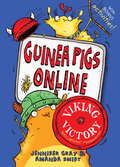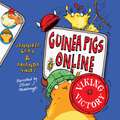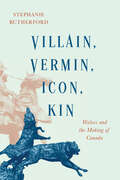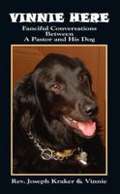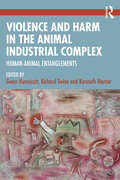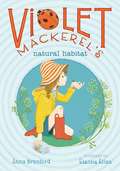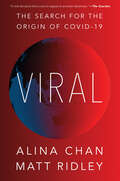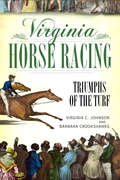- Table View
- List View
Viking Victory (Guinea Pigs Online #4)
by Jennifer Gray Amanda SwiftA nasty builder with a huge digger is threatening the guinea pigs' woodland! The furry pals must protect it - but how? Terry wants to tell all his friends online... Eduardo thinks a protest song will do the trick... While Coco just wants everyone to get on with it! Then they meet Olaf the Viking guinea pig who claims to be over 1,000 years old. Can they use his ancient tactics to help fight the builder?
Viking Victory (Guinea Pigs Online #4)
by Jennifer Gray Amanda SwiftA nasty builder with a huge digger is threatening the guinea pigs' woodland! The furry pals must protect it--but how?Terry wants to tell all his friends online. Eduardo thinks a protest song will do the trick. While Coco just wants everyone to get on with it! Then they meet Olaf the Viking guinea pig who claims to be over 1,000 years old. Can they use his ancient tactics to help fight the builder?(P)2014 WF Howes Ltd
Viking Victory (Guinea Pigs Online Ser. #3)
by Jennifer Gray Amanda SwiftA nasty builder with a huge digger is threatening the guinea pigs' woodland! The furry pals must protect it - but how? Terry wants to tell all his friends online... Eduardo thinks a protest song will do the trick... While Coco just wants everyone to get on with it! Then they meet Olaf the Viking guinea pig who claims to be over 1,000 years old. Can they use his ancient tactics to help fight the builder?
Village Horse Doctor
by Ben K. GreenIn the inimitable yarn-spinning fashion of Horse Tradin' and Wild Cow Tales, Ben K. (Doc) Green now takes us back with him to the deep Southwest and the never-a-dull-moment years he spent as practicing horse doctor--working out of Fort Stockton, Texas--along the Pecos and the Rio Grande, in one of the last big "horse countries" of North America. With precious little formal schooling, but with a perfect (if sometimes profane) corralside manner and plenty of natural wit, Doc became the first to hang up a shingle out there in the trans-Pecos country. And he didn't start small! The territory he had for his practice was 420 miles north and south by 360 miles east and west. And he covered that territory by all means known to man--shank's mare, horseback, buckboard, and (his standby for long hauls) a beat-up old coupe on whose body panels he kept his books in chalk. To go with Doc on his rounds, visiting his "patients," is a nostalgic and hilarious journey into a spacious yesterday--and a liberal education in the kind of horse and cow savvy of which precious little remains in the modern world. As a horseman it was a savvy he came by naturally. But perhaps he learned most from his own research: his own book on horse confirmation, privately published in several printings, is still a bible among practical horsemen; his research in his own laboratory on horse colors and pigmentation has made him an expert on what makes a "strawberry roan" or a "coyote dun." But the meat of Ben Green's books is in his yarns. To hear him tell the tales of his struggles with mean and friendly stockmen, yellowweed fever, banditos, poison hay, and "drouth"--to say nothing of his canny mix of science and horse sense when treating animals "that ain't house pets"--is a 100-proof old-time pleasure.
Villager Jim's Bobbin Robin
by Villager JimOver many years, Villager Jim has gained the trust of a number of special birds and animals who have gradually taken it as second nature that a member of their own small world is a large chap with a camera!Bobbin Robin and her friends have a huge social media audience, with tens of thousands of viewers following her weekly adventures from the RSPB and on Facebook.Bobbin the robin has now become rather adept at posing for Jim, perching on various platforms for wherever Jim sits in his garden.Open up the book to see the daily goings-on of these wildlife friends in some of Jims very best pictures taken in this beautiful setting. They illustrate the close relationship Jim has formed with Bobbin and her friends.Jims lively captions express the mood and spontaneous character of each individual shot and are an essential element of what makes his pictures so special.
Villager Jim's Garden Wildlife
by Villager JimBirds, bees, and a whole host of other flora and fauna that share Villager Jims garden in the tiny Peak District village of Foolow, are featured in this stunning book of photographs. Bobbin Robin is just one of the regular visitors to the garden; she and her friends have a huge social media audience, with tens of thousands of viewers. Open up the book to see the daily goings on of these wildlife friends in some of Jims very best pictures taken in this beautiful setting. They illustrate the close relationship Jim has formed with some of the regular wildlife visitors to his garden. His quirky captions capture the mood and spontaneous character of each individual shot and are an essential element of what makes Villager Jims pictures so special.
Villager Jim's Garden Wildlife
by Villager JimBirds, bees, and a whole host of other flora and fauna that share Villager Jims garden in the tiny Peak District village of Foolow, are featured in this stunning book of photographs. Bobbin Robin is just one of the regular visitors to the garden; she and her friends have a huge social media audience, with tens of thousands of viewers. Open up the book to see the daily goings on of these wildlife friends in some of Jims very best pictures taken in this beautiful setting. They illustrate the close relationship Jim has formed with some of the regular wildlife visitors to his garden. His quirky captions capture the mood and spontaneous character of each individual shot and are an essential element of what makes Villager Jims pictures so special.
Villager Jim's Highland Cows
by Villager JimHugely charismatic, the Highland cattle breed is the focus of this photographic tribute to one of Britains most popular farm animals. These long-horned, curly coated cows are amongst the many now famous subjects featured in Villager Jims daily online photographic adventures, which have gained nearly 200,000 followers.Jim often wanders amongst the herds throughout the seasons, taking shots from many different angles as they graze on moorland, heathland, woodland copses and lush green farmland. Getting close to one to photograph is always a respectful journey; although they are normally very peaceful animals, Jim is always mindful to stay within their field of view and not invade their space too much.Despite rarely seeing their eyes, many of Jims shots have a comedy element to them, with the cows fondness for constant nose cleaning and their serious but amusing expressions semi-hidden behind masses of tangly hair.Through this book, Jim is very proud to help grow the following for this most beautiful breed of cattle.
Villager Jim's Moorland Wildlife
by Villager JimVillager Jim, the famous Peak District photographer, takes us on a journey to his very favorite places on the moors surrounding the Peak District National Park, where he lives. From wonderful wild deer to breathtaking buzzards and other birds of prey, Jim allows us a glimpse of his daily moorland travels with all the abundant wildlife that lives in that part of the world. Jim often concedes that it is his most favorite place on earth, being out alone with his camera within this unforgiving landscape, watching the sun rise on the horizon, whilst at the same time, seeing stags wander, grazing on the moorland. It is here also that many of his favorite birds of prey abound. And, of course, he is there to capture the beautiful landscape shots rolling in mists or washed in the golden light of dawn.
Villain, Vermin, Icon, Kin: Wolves and the Making of Canada
by Stephanie RutherfordA wolf’s howl is felt in the body. Frightening and compelling, incomprehensible or entirely knowable, it is a sound that may be heard as threat or invitation but leaves no listener unaffected.Toothsome fiends, interfering pests, or creatures wild and free, wolves have been at the heart of Canada’s national story since long before Confederation. Villain, Vermin, Icon, Kin contends that the role in which wolves have been cast – monster or hero – has changed dramatically through time. Exploring the social history of wolves in Canada, Stephanie Rutherford weaves an innovative tapestry from the varied threads of historical and contemporary texts, ideas, and practices in human-wolf relations, from provincial bounties to Farley Mowat’s iconic Never Cry Wolf. These examples reveal that Canada was made, in part, through relationships with nonhuman animals. Wolves have always captured the human imagination. In sketching out the connections people have had with wolves at different times, Villain, Vermin, Icon, Kin offers a model for more ethical ways of interacting with animals in the face of a global biodiversity crisis.
Villains Academy (Villains Academy #1)
by Ryan HammondBeing BAD has never felt so GOOD! The first in a villainously funny, highly illustrated young middle-grade series from author-illustrator Ryan Hammond. For fans of Amelia Fang, Dog Man and Grimwood. Don't miss the second installment, How to Steal a Dragon, out in October 2023, and the third installment, How to Win the Gruesome Games, out in April 2024! &‘Frightfully fun – Villains Academy had me cackling from the very first page!&’ Katie Tsang, co-author of the Dragon Realm series &‘I loved the spookily funny Villains Academy. It's a work of (evil) genius!&’ Jenny McLachlan, author of The Land of RoarWelcome to Villains Academy – the most prestigious villain school in the ENTIRE land. You will either leave here as a fully-formed villain . . . or in tatters. It's werewolf Bram&’s first day at Villains Academy. He really doesn&’t feel like a villain at all, but the coveted Villain of the Week trophy is up for grabs, and Bram knows he&’ll have to dig deep. With the help of new friends Mona the elf-witch, Bryan the lion, Shelia the ghost and Tony the skeleton, can Bram find his inner badness and become the villain he's always dreamed of being?PRAISE FOR VILLAINS ACADEMY: &‘A charmingly villainous adventure about friendship, school and unspeakable evil. Hammond is an exciting new author-illustrator double threat.&’ Louie Stowell, author of Loki: A Bad God&’s Guide to Being Good &‘Criminally fun!&’ Danny Wallace, author of The Day the Screens Went Blank &‘Heart-warming and hilarious – Villains Academy is a spookalicious treat, set to terrify every other book on your shelf.&’ Jack Meggitt-Phillips, author of The Beast and the Bethany &‘An absolute HOOT! Evil laughs aplenty!&’ Sophy Henn, author and illustrator of the Pizazz series &‘A joyful hug of a book with genuine warmth and heart.&’ Hannah Gold, author of The Last Bear &‘A delightfully fun adventure with real heart and humour.&’ Benjamin Dean, author of Me, My Dad and the End of the Rainbow &‘Immersive, funny, and with a cast of scarily loveable characters, Villains Academy made me feel like I was IN the book!&’ Mel Taylor-Bessent, author of The Christmas Carrolls &‘A fabulously funny adventure. I want to enrol in Villains Academy!&’ Nick Sheridan, author of The Case of the Runaway Brain &‘Wickedly funny and full of quirky yet loveable characters.&’ Iona Rangeley, author of Einstein the Penguin &‘This is a brilliant, bonkers work packed with top-notch illustration.&’ Jack Noel, author and illustrator of the Comic Classics series &‘Full of wonderful characters, Villains Academy is such a FUN read!&’ Rikin Parekh, illustrator of The Worst Class in the World series
Vilonia Beebe Takes Charge
by Kristin L. GrayVilonia is determined to prove she’s responsible enough to care for a dog in this hilarious and utterly lovable debut novel.Being responsible is NOT easy. Fourth grader Vilonia hasn’t lost her rain coat in the three weeks she’s had it and she’s brushed her teeth every night and she’s volunteered to be the Friday Library Helper. But all that hard work is worth it if it means she can get a dog. Besides, this dog isn’t just because Vilonia has wanted one for pretty much ever. It’s also to help Mama, who’s been lost in one, big sadness fog for forty-three days—ever since Nana died. But Vilonia read that pets can help with sadness. Now all she has to do is keep the library goldfish alive over spring break, stop bringing stray animals home, and help Mama not get fired from her job. And she’s got to do all of it before the Catfish Festival. Easy as pie, right? Tremendous voice, humor, and heart make this debut novel utterly lovable.
Vinnie Here: Fanciful Conversations Between A Pastor And His Dog
by Joseph Kraker VinnieA collection of meditations in three parts. First is a brief statement of each topic from celebrating holidays, to resisting consumerism, to helping the poor, to getting along, to adapting to change, to facing adversity. Second a conversation about the theme between the pastor and his dog, who sometimes teaches, and sometimes learns while seeing the world through a dog's innocent eyes, concerned with food, toys, walks, coping with people and other animals, and balancing his instincts to please himself and his beloved master. These capture the pastor's and dog's personalities and are based on Vinnie's actual experiences from walking in subzero weather to being hit by a car to being unfriendly to a donkey. They are clear, often humorous and always uplifting little parables. Third are three brief suggestions for personal reflection to encourage readers to think more deeply about each topic and find its personal relevance. About this book the author says: "Anybody who has a dog and therefore talks to his or her dog will appreciate the spirit in which these stories are written. Like me, you not only talk to your dog, but you also provide the dog's answers, and thus comes the dialogue. The one addition I have made in compiling these stories is the introductions, which show that I actually had a thought in mind each time I sat down to write. The discussion questions at the end of each story may prove helpful. If not, disregard them." Pictures are described.
Violence and Harm in the Animal Industrial Complex: Human-Animal Entanglements
by Richard Twine Gwen Hunnicutt Kenneth MentorThis book grapples with multispecies violent exploitations embedded in corridors of power within the animal-industrial complex (A-IC). The A-IC is a useful framework for understanding how exploitative human-animal relations are central to capitalist relations and profit accumulation. ‘A-IC-related-violence’ – killing animals for economic gain – has a ripple effect which results in profound consequences for humans as well.This collection of international scholarship explores topics as varied as how A-IC-related-violence is reproduced and sustained through rapidly changing discursive strategies, ideological architecture, and particular cultural forms that elide and legitimize animal cruelty. Several chapters expose collusion between governments, corporations, and academia as central to maintaining dominance of A-IC-related-violence. Other scholars explore the trouble with making the conditions of “meat” production visible – of de-fetishizing meat commodities. The scholarship critically explores dynamic components of an apparatus that enables A-IC-related-violence and harm but is situated within the capitalist order and charts A-IC-related-violence as the key profit-generating practice in select domains of the A-IC.The book unmasks inherent cruelties in a proliferation of social forms that ultimately reflect a socioeconomic system that centralizes capitalist life characterized by endless growth, competitiveness, and profligate consumption. This is essential reading for those engaged in critical criminology, green criminology, violence studies, peace and conflict studies, critical animal studies, or animal rights-oriented scholars.
Violet Mackerel's Natural Habitat
by Elanna Allen Anna BranfordViolet is back with a little bit of helpfulness and a whole lot of heart in this third book of the effervescent Violet Mackerel series.Violet is the smallest in her family, and has a special affinity for Small Things everywhere. So when she finds a tiny ladybug in the garden, she expects she knows how it feels. It probably has to go to bed before all the others, and whenever it finds out something interesting (like that your ears keep growing all your life even when you are old), the bigger ladybugs probably say they already knew. Violet wants to help the ladybug, so she names her Small Gloria, puts her in a jar, and feeds her cheese toast. And then Violet wakes up to a horrible surprise. But thankfully, even as Violet learns a hard lesson about natural habitats, she realizes how nice it is to share her own habitat with a big sister.
Violet Mackerel's Natural Habitat
by Elanna Allen Anna BranfordViolet is back with a little bit of helpfulness and a whole lot of heart in this third book of the effervescent Violet Mackerel series.Violet is the smallest in her family, and has a special affinity for Small Things everywhere. So when she finds a tiny ladybug in the garden, she expects she knows how it feels. It probably has to go to bed before all the others, and whenever it finds out something interesting (like that your ears keep growing all your life even when you are old), the bigger ladybugs probably say they already knew. Violet wants to help the ladybug, so she names her Small Gloria, puts her in a jar, and feeds her cheese toast. And then Violet wakes up to a horrible surprise. But thankfully, even as Violet learns a hard lesson about natural habitats, she realizes how nice it is to share her own habitat with a big sister.
Violet Mackerel's Natural Habitat
by Elanna Allen Anna BranfordViolet is back with a little bit of helpfulness and a whole lot of heart in this third book of the effervescent Violet Mackerel series.Violet is the smallest in her family, and has a special affinity for Small Things everywhere. So when she finds a tiny ladybug in the garden, she expects she knows how it feels. It probably has to go to bed before all the others, and whenever it finds out something interesting (like that your ears keep growing all your life even when you are old), the bigger ladybugs probably say they already knew. Violet wants to help the ladybug, so she names her Small Gloria, puts her in a jar, and feeds her cheese toast. And then Violet wakes up to a horrible surprise. But thankfully, even as Violet learns a hard lesson about natural habitats, she realizes how nice it is to share her own habitat with a big sister.
Violet and Victor Write the Most Fabulous Fairy Tale
by Alice Kuipers Bethanie Deeney MurguiaViolet and Victor work together to write a truly enchanted tale!Violet is determined to write the most fabulous fairy tale that has ever been imagined! Her twin, Victor, is not in the mood for make-believe."I was born in a castle!" Violet says."You were born in a hospital," Victor replies.But when an evil witch arrives in Violet's story, will Victor help write an ending that saves the day? Join the twins on an adventure through Fairy Tale Kingdom as they celebrate the joy of storytelling and reading!
Viral Hemorrhagic Fevers
by Sunit K. Singh Daniel RuzekViral hemorrhagic fevers have captured the imagination of the public and made their way into popular books and movies by virtue of their extreme virulence and mysterious origins. Since 2001, concerns have grown about the potential use of many hemorrhagic fever viruses as biological weapons. This has led to a resurgence in research to develop improv
Viral Vectors in Veterinary Vaccine Development: A Textbook
by Thiru Vanniasinkam Suresh K. Tikoo Siba K. SamalThis highly accessible textbook introduces readers to the development of viral vectors and discusses their application in veterinary vaccinology. It offers comprehensive information on the latest advances in this emerging research field, together with a broad overview of the history of veterinary vaccines and viral vectors. The book also addresses issues concerning funding, translational research and ethics that will impact the future development, manufacture and global use of viral vector-based veterinary vaccines. The book addresses the needs of graduate students and researchers in the fields of Veterinary Medicine, Virology and Immunology.
Viral: The Search for the Origin of Covid-19
by Matt Ridley Alina Chan"Chan and Ridley write with an urgency...that inspires gripping depictions of what viruses are, how infectious-disease laboratories work and wonderfully lucid descriptions of bats. . . . They powerfully recount how dangerous pathogens can both leak from a lab and emerge in nature." (New York Times Book Review) Understanding how Covid-19 started is crucial for the future of humankind. Viral is the most incisive and authoritative book about the search for the source of the virus.A new virus descended on the human species in 2019 wreaking unprecedented havoc. Finding out where it came from and how it first jumped into people is an urgent priority, but early expectations that this would prove an easy question to answer have been dashed. Nearly two years into the pandemic, the crucial mystery of the origin of SARS-CoV-2 is not only unresolved but has deepened. In this uniquely insightful book, a scientist and a writer join forces to try to get to the bottom of how a virus whose closest relations live in bats in subtropical southern China somehow managed to begin spreading among people more than 1,500 kilometres away in the city of Wuhan. They grapple with the baffling fact that the virus left none of the expected traces that such outbreaks usually create: no infected market animals or wildlife, no chains of early cases in travellers to the city, no smouldering epidemic in a rural area, no rapid adaptation of the virus to its new host—human beings. To try to solve this pressing mystery, Viral delves deep into the events of 2019 leading up to 2021, the details of what went on in animal markets and virology laboratories, the records and data hidden from sight within archived Chinese theses and websites, and the clues that can be coaxed from the very text of the virus’s own genetic code. The result is a gripping detective story that takes the reader deeper and deeper into a metaphorical cave of mystery. One by one the authors explore promising tunnels only to show that they are blind alleys, until, miles beneath the surface, they find themselves tantalisingly close to a shaft that leads to the light.
Virals (Virals #1)
by Kathy ReichsAdventure is in Tory Brennan's blood. After all, she's the grandniece of world-famous forensic anthropologist Temperance Brennan. Always up for a challenge, Tory and her science-geek friends spend their time exploring the marshlands of Loggerhead Island, home to the very off-limits Loggerhead Island Research Institute, where something strange is going on. <p><p>After rescuing a stray wolfdog pup from a top-secret lab, Tory and her friends are exposed to a rare strain of canine parvovirus, changing them--and their DNA--forever. Now they are more than friends. They are a pack. They are Virals. And they're dangerous to the core. But are they unstoppable enough to catch a cold-blooded murderer? ~From the Trade Paperback edition.
Virginia Horse Racing: Triumphs of the Turf (Sports)
by Virginia C. Johnson Barbara CrookshanksVirginia, mother of presidents, is also the mother of American horse racing. From the very beginning, Virginians have risked it all on the track as eagerly as on the battlefield. Follow the bloodlines of three foundation sires of the American Thoroughbred through generations of rollicking races and larger-than-life grandees wagering kingly stakes, sometimes on horses not yet born. How did the horse nicknamed Damn His Eyes get protection money from other horse owners? What did it mean to �tap the claret� to break a neck-and-neck tie? Why was Confederate cavalry so much better than Union�was it the riders, or was it the mounts? All these and many more stories of horsemanship on and off the track fill the pages of Virginia Horse Racing: Triumphs of the Turf.
Virginia Woolf and Neuropsychiatry
by Maxwell BennettThis book, written by one of the leaders in the field of the neurosciences, will give an explanation of the symptoms and eventual untimely suicide of one of literatures greatest authors; Virginia Woolf. The sources used are letters and statements from Woolf herself, the literature she wrote and comments, letters and any other documentation that referred to her mental state and her medical status. The author will use current insight into depression, the mental consequences of child abuse and drug interactions/effects to illustrate this case study. The book should appeal to researchers in the neurosciences, psychology and psychiatry as well as to a broader audience, mainly individuals who are interested in the (external and internal) forces that drove Woolf to write her material.
Virus Infection and Tumorigenesis: Hints from Marine Hosts’ Stress Responses
by Xiaobo ZhangThis book reviews the latest research on the molecules and mechanisms of marine host stress responses to viral infections and tumorigenesis. It offers an overview of the state of the art in the field as well as future directions. Metabolism disorder is a characteristic of tumorigenesis. Since viruses complete their life cycle in host cells, such infections cause metabolic disorders in the host. As such, the mechanisms of virus pathogenesis and tumor progression are similar or even identical. In essence, the role of antiviral molecules is to maintain the metabolic homeostasis of infected host cells, and the antiviral molecules induced by virus infection may play an important role in antitumor pathways, resulting in cancer cell death or restoring the disordered metabolism of cancer cells. The molecules generated during host stress responses to viruses can also contribute to the antitumor mechanisms in humans. However, the relationship between host stress responses to virus infection and tumorigenesis has not been extensively explored. In recent years, studies have shown that marine host stress responses to viral invasion can be good models for exploring human antitumor mechanisms. Stimulating further research in the field, this book offers graduate students and researchers with comprehensive insights into host stress responses to viral invasion and tumor progression. It is also a valuable resource for those working in the pharmaceutical industry interested in drug discovery based on molecules derived from host stress responses to viral infection.
